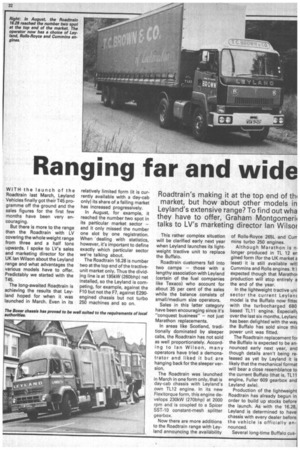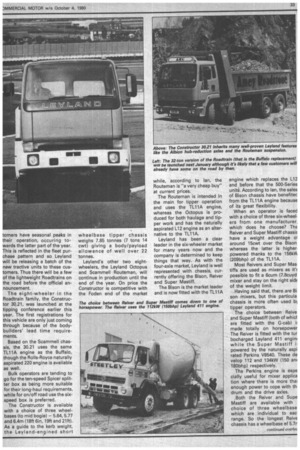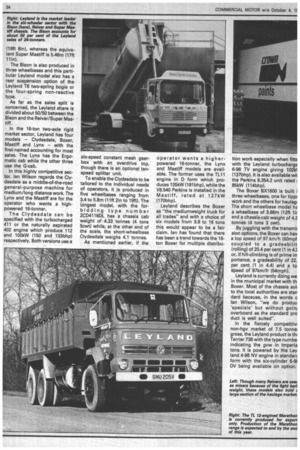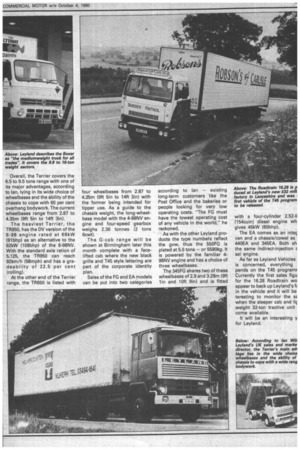Ranging far and wide
Page 34

Page 35

Page 36

Page 37

If you've noticed an error in this article please click here to report it so we can fix it.
Roadtrain's making it at the top end of till market, but how about other models in Leyland's extensive range? To find out wha they have to offer, Graham Montgomeril talks to LV's marketing director Ian Wilsor
WITH the launch of the Roadtrain last March, Leyland Vehicles finally got their T45 programme off the ground and the sales figures for the first few months have been very encouraging.
But there is more to the range than the Roadtrain with LV covering the whole weight range from three and a half tons upwards. I spoke to LV's sales and marketing director for the UK Ian Wilson about the Leyland range and what advantages the various models have to offer. Predictably we started with the T45.
The long-awaited Roadtrain is achieving the results that Leyland hoped for when it was launched in March. Even in its relatively limited form (it is currently available with a day-cab only) its share of a falling market has increased progressively.
In August, for example, it reached the number two spot in its particular market sector — and it only missed the number one slot by one registration. When 'dealing with statistics, however, it's important to define exactly which particular sector we're talking about.
The Roadtrain 16.28 is number two at the top end of the tractiveunit market only. Thus the dividing line is at 195kW (260bhp) net installed, so the Leyland is competing, for example, against the F10 but not the F7, against E290engined chassis but not turbo 250 machines and so on. This rather complex situation will be clarified early next year when Leyland launches its lightweight tractive unit to replace the Buffalo.
Roadtrain customers fall into two camps — those with a lengthy association with Leyland (certain of the fuel companies like Texaco) who account for about 35 per cent of the sales while the balance consists of small/medium size operators.
Sales in this latter category have been encouraging since it's "conquest business" — not just Marathon replacements.
In areas like Scotland, traditionally dominated by sleeper cabs, the Roadtrain has not sold as well proportionately. According to Ian Wilson, many operators have tried a demonstrator and liked it but are hanging back for the sleeper version.
The Roadtrain was launched in March in one form only, that is day-cab chassis with Leyland's own TL12 engine. In its new Flexitorque form, this engine develops 230kW (270bhp) at 2000 rpm and is coupled to a Spicer SST-10 constant-mesh splitter gearbox.
Now there are more additions to the Roadtrain range with Leyland announcing the availability of Rolls-Royce 265L and Curr mins turbo 250 engines.
Although Marathon is n, longer produced in TL 12 en
gined form (for the UK market a least) it is still available witl Cummins and Rolls engines. It i expected though that Marathor production will stop entirely a the end of the year.
In the lightweight tractive uni sector the current Leylant model is the Buffalo now fittec with the turbocharged 680 based TL11 engine. Especially over the last six months, Leylanc has been delighted with the way the Buffalo has sold since this power unit was fitted.
The Roadtrain replacement for the Buffalo is expected to be announced early next year, and though details aren't being released as yet by Leyland it is likely that the mechanical format will bear a close resemblance to the current Buffalo (that is, TL11 engine, Fuller 609 gearbox and Leyland axle).
Production of the lightweight Roadtrain has already begun in order to build up stocks before' the launch. As with the 16.28, Leyland is determined to have chassis with every dealer before the vehicle is officially announced.
Several long-time Buffalo cus tomers have seasonal peaks in their operation, occuring towards the latter part of the year. This is reflected in the fleet purchase pattern and so Leyland will be releasing a batch of the new tractive units to these customers. Thus there will be a few of the lightweight Roadtrains on the road before the official announcement.
The eight-wheeler in the Roadtrain family, the Constructor 30.21, was launched at the tipping conference earlier this year. The first registrations for this vehicle are only just coming through because of the bodybuilders' lead time requirements.
Based on the Scammell chassis, the 30.21 uses the same TL11A engine as the Buffalo, though the Rolls-Royce naturally aspirated 220 engine is available as well.
Bulk operators are tending to go for the ten-speed Spicer splitter box as being more suitable for their long-haul requirements, while for on/off road use the sixspeed box is preferred.
The Constructor is available with a choice of three wheelbases (to mid bogie) — 5.64, 5.77 and 6.4m (18ft 6in, 19ft and 21ft). As a guide to the kerb weight, the Leyland-engined short wheelbase tipper chassis weighs 7.85 tonnes (7 tons 14 cwt) giving a body/payload allowance of well over 22 tonnes.
Leyland's other two eightwheelers, the Leyland Octopus and Scammell Routeman, will continue in production until the end of the year. On price the Constructor is competitive with the Foden end of the market while, according to Ian, the Routeman is "a very cheap buy" at current prices.
The Routeman is intended in the main for tipper operation and uses the TL11A engine, whereas the Octopus is produced for both haulage and tipper work and has the naturally aspirated L12 engine as an alternative to the TL11A.
Leyland has been a clear leader in the six-wheeler market for many years now and the company is determined to keep things that way. As with the four-axle market, Leyland is well represented with chassis, currently offering the Bison, Reiver and Super Mastiff.
The Bison is the market leader and is now fitted with the TL11A engine which replaces the L12 and before that the 500-Series units. According to Ian, the sales of Bison chassis have benefitec from the TL11A engine because of its great flexibility.
When an operator is faced with a choice of three six-wheelers from one manufacturer, which does he choose? The Reiver and Super Mastiff chassis have a weight advantage ol around 15cwt over the Bison whereas the latter is higher. powered thanks to the 15610A (209bhp) of the TL11A.
Most Reivers and Super Mas tiffs are used as mixers as in possible to fit a 6cum (7.8cuyd mixer and stay on the right sick of the weight limit.
Having said that, there are Bi son mixers, but this particula chassis is more often used ID) tipper operators.
The choice between Reive and Super Mastiff (both of whick are fitted with the G-cab) made totally on horsepower The Reiver is fitted with the tur bocharged Leyland 411 engin( while the Super Mastiff powered by the naturally aspi rated Perkins V8540. These de velop 112 and 134kW (150 an 180bhp) respectively.
The Perkins engine is espe dally useful for mixer applica tion where—there is more thai enough power to cope with th. drum and the drive axles.
Both the Reiver and Supe Mastiff are available with choice of three wheelbase which are individual to eac range. So the longest Reive chassis has a wheelbase of 5.7r (18ft 8in), whereas the equivalent Super Mastiff is 5.46m (17ft The Bison is also produced in three wheelbases and this particular Leyland model also has a rear suspension option of the Leyland T6 two-spring bogie or the four-spring non-reactive type.
As far as the sales split is concerned, the Leyland share is divided about 50/50 between the Bison and the Reiver/Super Mastiff.
In the 16-ton two-axle rigid market sector, Leyland has four models — Clydesdale, Boxer, Mastiff and Lynx — with the first-named accounting for most sales. The Lynx has the Ergomatic cab while the other three use the G-cab.
In this highly competitive sector, Ian Wilson regards the Clydesdale as a middle-of-the-road general-purpose machine for medium/long distance work. The Lynx and the Mastiff are for the operator who wants a highpowered 16-tanner.
The Clydesdale can be specified with the turbocharged 411 or the naturally aspirated 402 engine which produce 112 and 100kW (150 and 133bhp) respectively. Both versions use a six-speed constant mesh gearbox with an overdrive top, though there is an optional tenspeed splitter unit.
To enable the Clydesdale to be tailored to the individual needs of operators, it is produced in five wheelbases ranging from 3.4 to 5.8m (lift 2in to 19ft). The longest model, with the forbidding type number 2CD4116DL has a chassis cab weight of 4.33 tonnes (4 tons 5cwt) while, at the other end of the scale, the short-wheelbase Clydesdale weighs 4.1 tonnes.
As mentioned earlier, if the operator wants a higherpowered 16-tonner, the Lynx and Mastiff models are available. The former uses the TL11 engine in D form which produces 135kW (181 bhp), while the V8.540 Perkins is installed in the Mastiff, rated at 1 2 7kW (170bhp).
Leyland describes the Boxer as "the mediumweight truck for all trades" and with a choice of six models from 9.8 to 16 tons this would appear to be a fair claim. Ian has found that there has been a trend towards the 16ton Boxer for multiple distribu tion work especially when fittE with the Leyland turbochargE 6-98 TV engine giving 102k1 (137bhp). It is also available wit the Perkins 6.354.2 unit rated i 85kW (114bhp).
The Boxer BX1600 is built i three wheelbases, one for tipp( work and the others for haulagi The short wheelbase model ha a wheelbase of 3.68m (12ft 1ir and a chassis-cab weight of 4.2 tonnes (4 tons 3 cwt).
By juggling with the transmh sion options, the Boxer can hay a top speed of 97 km/h (60mpt coupled to a gradeabilit (rolling) of 20.4 per cent (1 in 4.E. or, if hill-climbing is of prime inportance, a gradeability of 22. per cent (1 in 4.4) and a to speed of 87km/h (54mph).
Leyland is currently doing we in the municipal market with th Boxer. Most of the chassis soli to the local authorities are stan dard because, in the words ci Ian Wilson, "we do produci 'specials' but without goini overboard as the standard pro duct is well suited".
In the fiercely competitivi non-hgv market of 7.5 tonne!
gross, the Leyland product is thi Terrier 738 with the type numbe indicating the gvw in lmperia tons. It is powered by the Ley land 4-98 NV engine in standarc form with the six-cylinder 6-9i DV being available on option. Overall, the Terrier covers the 6.5 to 9.5 tons range with one of its major advantages, according to Ian, lying in its wide choice of wheelbases and the ability of the chassis to cope with 60 per cent overhang bodywork. The current wheelbases range from 2.87 to 4.35m (9ft Sin to 14ft 3in).
The heaviest Terrier, the TR950, has the DV version of the 6-98 engine rated at 68kW (91bhp) as an alternative to the 82kW (109bhp) of the 6-98NV. With the standard axle ration of 5.125, the TR950 can reach 92km/h (58mph) and has a gradeability of 22.5 per cent (rolling).
At the other end of the Terrier range, the TR650 is listed with four wheelbases from 2.87 to 4.35m (9ft Sin to 14ft 3in) with the former being intended for tipper use. As a guide to the chassis weight, the long-wheelbase model with the 4-98NV engine and four-speed gearbox weighs 2.36 tonnes (2 tons 6cwt).
The G-cab range will be shown at Birmingham later this month complete with a facelifted cab where the new black grille and T45 style lettering are part of the corporate identity plan.
Sales of the FG and EA models can be put into two categories according to Ian — existing long-term customers like the Post Office and the bakeries or people looking for very low operating costs. "The FG must have the lowest operating cost of any vehicle in the world," he reckoned.
As with the other Leyland products the type numbers reflect the gvw, thus the 550FG is plated at 5.5 tons — or 5590kg. It is powered by the familiar 498NV engine and has a choice of three wheelbases.
The 345FG shares two of these wheelbases of 2.9 and 3.28m (9ft 1in and 10ft 9in) and is fitted with a four-cylinder 2.52-li (154cuin) diesel engine wh gives 45kW (613bhp).
The EA comes as an intec van and a chassis/cowel as 440EA and 345EA. Both sh the same indirect-injection sel qngine.
As far as Leyland Vehicles is concerned, everything pends on the T45 programr Currently the first sales figu for the 16.28 Roadtrain wo appear to back up Leyland's fi in the vehicle and it will be teresting to monitor the sE when the sleeper cab and lic weight 32-ton tractive unit come available.
It will be an interesting y for Leyland.












































































































